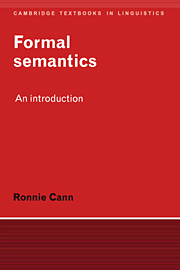Book contents
- Frontmatter
- Contents
- List of figures
- Preface
- List of symbols
- 1 INTRODUCTION
- 2 PREDICATES AND ARGUMENTS
- 3 NEGATION AND CO-ORDINATION
- 4 TYPE THEORY
- 5 THE LAMBDA OPERATOR
- 6 QUANTIFICATION
- 7 INFERENCE
- 8 TIME, TENSE AND ASPECT
- 9 POSSIBLE WORLDS
- 10 INTENSIONAL SEMANTICS
- Answers to selected exercises
- References
- Index
7 - INFERENCE
Published online by Cambridge University Press: 05 June 2012
- Frontmatter
- Contents
- List of figures
- Preface
- List of symbols
- 1 INTRODUCTION
- 2 PREDICATES AND ARGUMENTS
- 3 NEGATION AND CO-ORDINATION
- 4 TYPE THEORY
- 5 THE LAMBDA OPERATOR
- 6 QUANTIFICATION
- 7 INFERENCE
- 8 TIME, TENSE AND ASPECT
- 9 POSSIBLE WORLDS
- 10 INTENSIONAL SEMANTICS
- Answers to selected exercises
- References
- Index
Summary
Making inferences
The semantic theory developed up to Chapter 6 has concentrated mainly on the interpretation of sentences and phrases in isolation from each other, but one of the criteria for assessing the adequacy of a semantic theory set out in Chapter 1 is that it should account for the meaning relations that hold between different expressions in a language. This means, amongst other things, that the semantic theory proposed here ought to guarantee that, where reference and context are kept constant, the sentences in (1.b) and (1.c) are paraphrases of (1.a) while (1.d) and (1.e) are entailments of it and (1.f) and (1.g) are contradictions of it.
a. Jo stroked the cat and kicked the dog.
b. Jo kicked the dog and stroked the cat.
c. The cat was stroked by Jo and the dog was kicked by Jo.
d. Jo stroked the cat.
e. Someone kicked the dog.
f. The dog wasn't kicked.
g. No-one stroked anything.
The intuitively identified relations between the sentences in (1) derive from the interpretations of the conjunction and, the negative not and the quantifier pronouns no-one and someone. Such relations are generally referred to as logical entailments, paraphrases or contradictions. (Note that these terms are used ambiguously between the relation that holds amongst sentences, as here, and the product sentences themselves, as in the first paragraph above.)
Information
- Type
- Chapter
- Information
- Formal SemanticsAn Introduction, pp. 197 - 232Publisher: Cambridge University PressPrint publication year: 1993
